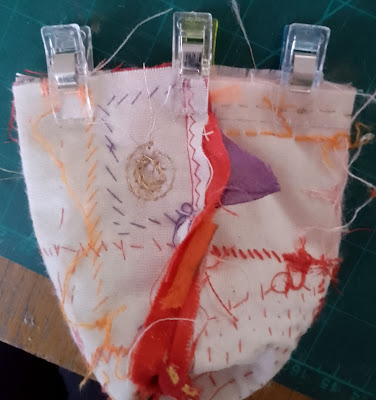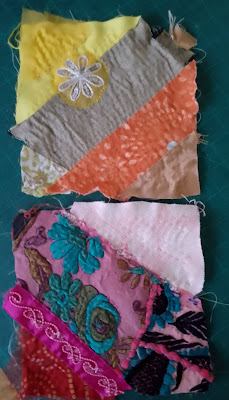This is a quick 'make' for anyone who wants a pincushion that's so bright you can't possibly mislay it! It's a simple triangular shape, and you can make it any size you like. I'd previously sewn this larger purple one. Proving you can leave off the sequinned trim and metallic thread if you really want to. Anyway, let's get started. You need two squares of equal size in a non-stretchy fabric. I used calico which gives a good strong base for you to stitch into. My squares were slightly over 4 inches. Pick out lots of fabric scraps, and if you're aiming for a boho style then choose lively colours and patterns. Arrange your scraps so you can't see any of the calico base. Use regular sewing thread or strands of embroidery thread to anchor your scraps down, adding decorative stitching and beads wherever you fancy. I know metallic thread can be a pain in the neck to sew with, but it does add a lovely sparkle. You can layer sheer and semi-sheers on top of plains, sew on buttons or ribbon, anything to add interest. Keep stitching and embellishing until you're happy with your two squares. Once that point's reached, pin or clip your squares right-sides-facing. Stitch around 3 sides, either by hand or machine. Here's the bit to make your pincushion into a triangle. If you wanted to make a straightforward square cushion, you'd now sew a line from of stitches from side seam to side seam. Instead, the centre seams are moved to the middle of that line. Pin or clip your unstitched edge as shown below. I sewed a few stitches on the left and the right of this unstitched edge, which you can see in the photo below if you look at the top corners. (It's so hard to write instructions and be clear enough! Hope this makes sense. If not, let me know.) This leaves a gap large enough to turn your cushion right sides out. Do so, and use a pencil or similar to make sure the corners are nice and pointy. Then take your cushion filling - I used polyester quilt wadding - and don't be stingy, make sure your cushion's well padded. After that, it's simply a question of sewing the gap closed. I covered my closure stitches over with a ribbon, just to make it look prettier. Even added a few more sequins too, for maximum bling.
Hope you like this, and let me know if you make your own version. I'd love to see them.
Okay, having written those instructions, and being in desperate need of a cuppa tea and possibly a little chocolate treat, I'll round things up with a last photo. Another couple of scrappy blocks made, for the quilt or cushion or rice bag or whatever I eventually make! Progress is being made, block by block ...
.jpg)
.jpg)










Comments
Post a Comment